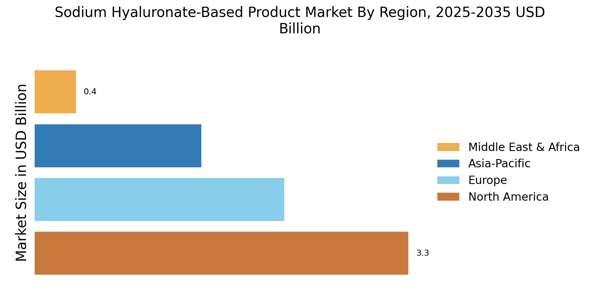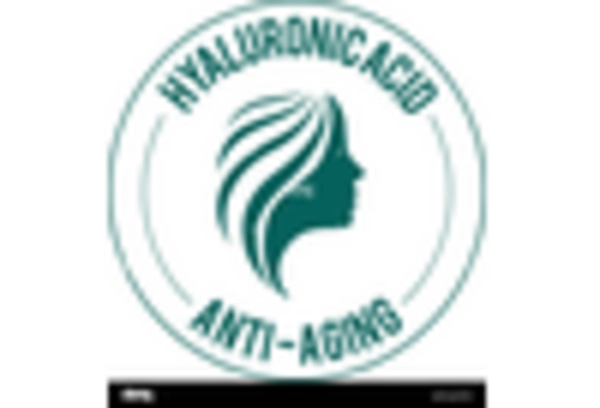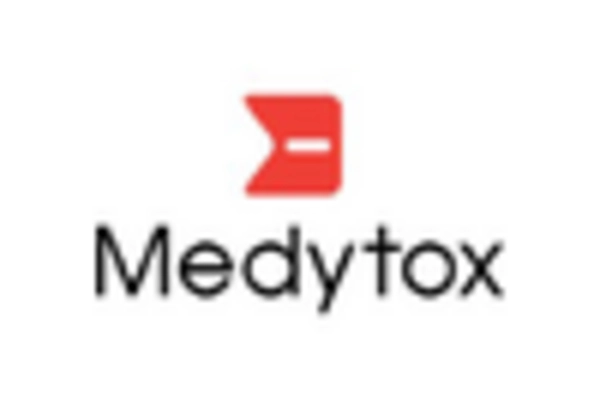Growth of E-Commerce Platforms
The Sodium Hyaluronate-Based Product Market is experiencing a notable impact from the growth of e-commerce platforms. With the increasing shift towards online shopping, consumers are more inclined to purchase skincare products through digital channels. This trend is particularly relevant for sodium hyaluronate-based products, as consumers often seek detailed information and reviews before making a purchase. E-commerce platforms provide a convenient avenue for consumers to access a wide range of products, including those containing sodium hyaluronate. Market analysis indicates that online sales of beauty and personal care products are expected to grow significantly, potentially reaching over 400 billion dollars by 2025. This growth in e-commerce is likely to enhance the visibility and accessibility of sodium hyaluronate-based products, thereby driving the Sodium Hyaluronate-Based Product Market.
Expansion of the Cosmetic Industry
The Sodium Hyaluronate-Based Product Market is benefiting from the overall expansion of the cosmetic industry. As The Sodium Hyaluronate-Based Product continues to grow, with an estimated value reaching over 800 billion dollars by 2025, the demand for innovative skincare solutions is intensifying. Sodium hyaluronate, recognized for its hydrating properties, is becoming a staple in various cosmetic formulations, including serums, creams, and masks. This expansion is further fueled by the increasing number of beauty brands entering the market, which often incorporate sodium hyaluronate into their product lines to attract consumers seeking effective skincare solutions. Consequently, this trend is likely to bolster the Sodium Hyaluronate-Based Product Market.
Increasing Awareness of Skin Health
The Sodium Hyaluronate-Based Product Market is experiencing a surge in consumer awareness regarding skin health. As individuals become more informed about the benefits of hydration and skin elasticity, the demand for products containing sodium hyaluronate is likely to rise. This ingredient is known for its ability to retain moisture, which is crucial for maintaining skin health. According to recent data, the market for skincare products is projected to grow at a compound annual growth rate of approximately 5.5% over the next few years. This trend suggests that consumers are increasingly prioritizing products that offer effective hydration solutions, thereby driving the growth of the Sodium Hyaluronate-Based Product Market.
Rising Popularity of Anti-Aging Products
The Sodium Hyaluronate-Based Product Market is significantly influenced by the rising popularity of anti-aging products. As the global population ages, there is a growing demand for products that can effectively combat signs of aging, such as fine lines and wrinkles. Sodium hyaluronate is widely recognized for its ability to plump and hydrate the skin, making it a key ingredient in many anti-aging formulations. Market data indicates that the anti-aging skincare segment is expected to witness substantial growth, with projections suggesting a market value exceeding 300 billion dollars by 2026. This increasing focus on anti-aging solutions is likely to drive the demand for sodium hyaluronate-based products, thereby enhancing the Sodium Hyaluronate-Based Product Market.
Consumer Preference for Multi-Functional Products
The Sodium Hyaluronate-Based Product Market is also being shaped by consumer preferences for multi-functional products. Modern consumers are increasingly seeking skincare solutions that offer multiple benefits, such as hydration, anti-aging, and skin repair. Sodium hyaluronate, with its versatile properties, fits well into this trend, as it can enhance skin moisture levels while also providing anti-aging benefits. This shift in consumer behavior is prompting manufacturers to develop innovative formulations that incorporate sodium hyaluronate, thereby expanding the product offerings within the Sodium Hyaluronate-Based Product Market. As a result, the market is likely to see a rise in products that cater to these evolving consumer demands.


















Leave a Comment